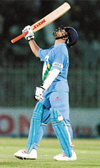Momentum Questions
Q1. The diagram below represents part of an experiment that is being used to estimate the speed of an air gun pellet. The pellet, which is moving parallel to the track, strikes the block, embedding itself. The trolley and the block then move along the track, rising a vertical height, h .

(a) Using energy considerations explain how the speed of the trolley and block immediately after it has been struck by the pellet, may be determined from measurements of h . Assume frictional forces are negligible.
(3 marks)
(b) The following data is collected from the experiment:
mass of trolley and block = 0.50 kg
mass of pellet = 0.0020 kg
speed of trolley and block immediately after impact = 0.40ms-1
Calculate
(i) the momentum of the trolley and block immediately after impact,
(ii) the speed of the pellet just before impact.
(4 marks)
(c)
(i) State what is meant by an inelastic collision.
(ii) Use the data from part (b) to show that the collision between the pellet and block is inelastic.
(4 marks)
(Total 11 marks)

Q2. A girl kicks a ball along the ground at a wall 2.0 m away. The ball strikes the wall normally at a velocity of 8.0 ms-1 and rebounds in the opposite direction with an initial velocity of 6.0 ms-1. The girl, who has not moved, stops the ball a short time later.
(a) Explain why the final displacement of the ball is not 4.0 m.
(1 mark)
(b) Explain why the average velocity of the ball is different from its average speed.
(2 marks)
(c) The ball has a mass of 0.45 kg and is in contact with the wall for 0.10 s. For the period of time the ball is in contact with the wall,
(i) calculate the average acceleration of the ball.
(ii) calculate the average force acting on the ball.
(iii) state the direction of the average force acting on the ball.
(5 marks)
(Total 8 marks)

Q3. The diagram represents an experiment that can be used to investigate stopping distances for a moving trolley.

The trolley is placed on the raised section of the track. When released it moves down the track and then travels along the horizontal section before colliding with the block. The trolley and block join and move together after the collision. The distance they move is measured.
(a) State the main energy changes taking place
(i) as the trolley descends,
(ii) after the collision, as the trolley and block move together.
(2 marks)
(b) Describe how the speed of the trolley, just before it collides with the block may be measured experimentally.
(3 marks)
(c) State and explain how the speed of the trolley, prior to impact could be varied.
(2 marks)
(Total 7 marks)

Q4. The diagram shows the velocity-time graph for a vertically bouncing ball, which is released above the ground at A and strikes the floor at B. The effects of air resistance have been neglected.

(a)
(i) What does the gradient of a velocity-time graph represent?
(ii) Explain why the gradient of the line CD is the same as line AB.
(iii) What does the area between the line AB and the time axis represent?
(iv) State why the velocity at C is negative.
(v) State why the speed at C is less than the speed at B.
(5 marks)
(b) The ball has a mass of 0.15 kg and is dropped from an initial height of 1.2m. After impact the ball rebounds to a height of 0.75m.
Calculate
(i) the speed of the ball immediately before impact,
(ii) the speed of the ball immediately after impact,
(iii) the change in momentum of the ball as a result of the impact,
(iv) the magnitude of the resultant average force acting on the ball during impact if it is in contact with the floor for 0.10 s.
(8 marks)
(Total 13 marks)

Q5.
The simplified diagram shows an experimental arrangement to investigate the collision of two trolleys.

In the experiment, trolley A is travelling at speed ν. It collides with and sticks to, the initially stationary trolley B.
(a) State the measurements you would need to take so that you could determine the speed of
(i) trolley A before the collision,
(ii) trolleys A and B after the collision.
(3 marks)
(b) Explain how you would verify that momentum was conserved in this collision, indicating what other measurements would be required.
(2 marks)
(c) State and explain what you would do to minimise the effects of friction on the motion of the trolleys.
(2 marks)
(7 Total)

Q6.
 (a) A cricketer throws a ball vertically upwards so that the ball leaves his hands at a speed of 25 ms-1. If air resistance can be neglected, calculate
(a) A cricketer throws a ball vertically upwards so that the ball leaves his hands at a speed of 25 ms-1. If air resistance can be neglected, calculate
(i) the maximum height reached by the ball,
(ii) the time taken to reach maximum height,
(iii) the speed of the ball when it is at 50% of the maximum height.
(4 marks)
(b) When catching the ball, the cricketer moves his hands for a short distance in the direction of travel of the ball as it makes contact with his hands.
Explain why this technique results in less force being exerted on the cricketer's hands.
(2 marks)
(6 Total)








 (a) A cricketer throws a ball vertically upwards so that the ball leaves his hands at a speed of 25 ms-1. If air resistance can be neglected, calculate
(a) A cricketer throws a ball vertically upwards so that the ball leaves his hands at a speed of 25 ms-1. If air resistance can be neglected, calculate 


